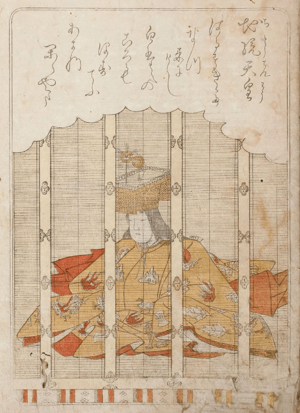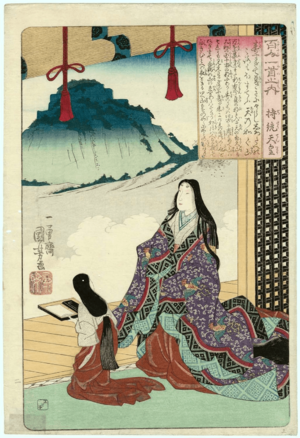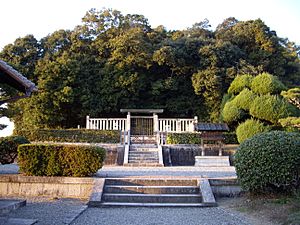Empress Jitō facts for kids
Quick facts for kids Empress Jitō持統天皇 |
|||||
|---|---|---|---|---|---|

Portrait of Empress Jitō by Katsukawa Shunshō, 18th century
|
|||||
| Empress of Japan | |||||
| Reign | 686–697 | ||||
| Predecessor | Tenmu | ||||
| Successor | Monmu | ||||
| Empress consort of Japan | |||||
| Tenure | 673–686 | ||||
| Born | Uno-no-sarara (鸕野讚良) 645 Japan |
||||
| Died | 13 January 703 (aged 57–58) Fujiwara-kyō, Japan |
||||
| Burial | Hinokuma-no-Ōuchi no misasagi (檜隈大内陵) (Nara) | ||||
| Spouse | Emperor Tenmu | ||||
| Issue | Prince Kusakabe | ||||
|
|||||
| House | Yamato | ||||
| Father | Emperor Tenji | ||||
| Mother | Soga no Ochi-no-iratsume | ||||
Empress Jitō (持統天皇, Jitō-tennō, 645 – 13 January 703) was the 41st ruler of Japan. She followed the traditional order of succession.
Empress Jitō ruled Japan from 686 to 697.
In the long history of Japan, Jitō was the third of eight women to become an empress regnant. The two empresses before her were Suiko and Kōgyoku (also known as Saimei). After Jitō, five more women ruled as empresses: Genmei, Genshō, Kōken (also known as Shōtoku), Meishō, and Go-Sakuramachi.
Contents
Empress Jitō's Story
Empress Jitō was the daughter of Emperor Tenji. Her mother was Ochi-no-Iratsume. Jitō married Emperor Tenmu, who was her father's full brother. She became empress after her husband's death.
Empress Jitō's birth name was Unonosarara or Unonosasara (鸕野讚良). Sometimes, she was simply called Uno.
Key Events During Her Rule
After her husband, Emperor Tenmu, passed away, Jitō took charge of the court. She became empress in 687. Her main goal was to make sure her son, Kusakabe-shinnō, would become the next ruler.
Empress Jitō ruled from the Fujiwara Palace in Yamato. In 689, she banned a game called Sugoroku. In 690, during her enthronement ceremony, she performed a special ritual and then gave pardon to many people. In 692, she visited the Ise Shrine. She did this even though her minister, Miwa-no-Asono-Takechimaro, advised her not to.
Prince Kusakabe was chosen to be the next crown prince. Sadly, he died when he was young. After his death, Kusakabe's son, Karu-no-o, was named as Jitō's successor. He later became known as Emperor Monmu.
Empress Jitō ruled for eleven years. Even though there were other empresses, their successors were usually male. This is why some scholars believe that women's reigns were only temporary. They argue that the tradition of only male rulers should continue. However, Empress Genmei was an exception. Her daughter, Empress Genshō, became empress after her.
In 697, Jitō decided to step down from the throne. She gave the throne to Monmu. After she retired, she took the special title of daijō-tennō. This means "retired sovereign." After her, other emperors who retired also used this title.
Jitō continued to have power even after retiring. She became a cloistered ruler. This means she ruled from behind the scenes. This became a common way for powerful people to influence politics in Japan.
Empress Jitō's Burial Place
The exact place where Empress Jitō is buried is known. This empress is honored at a memorial Shinto shrine called a misasagi in Nara.
The Imperial Household Agency is in charge of royal burial sites. They officially call this location Jitō's mausoleum. Its formal name is Ochi-no-Okanoe no misasagi.
Royal Family and Important Officials
Empress Jitō was born as Princess Uno-no-sarara (鸕野讃良皇女). Her father was Emperor Tenji. Her mother was a concubine named Hin. Jitō had two full siblings: Princess Ōta and Prince Takeru. Empress Jitō and her younger sister, Princess Ōta, both married Emperor Tenmu. Both sisters had children with him.
- Husband: Emperor Tenmu (天武天皇, Tenmu tennō, around 631 – October 1, 686). He was the son of Emperor Jomei and Empress Kōgyoku.
- Son: Crown Prince Kusakabe (草壁皇子, 662 – May 10, 689).
Important Court Officials
Kugyō (公卿) was a special name for the most powerful men in the emperor's court before the Meiji era.
This small group usually had only three or four men at a time. They were nobles who inherited their positions. Their experience helped them reach the highest levels of their careers. During Empress Jitō's reign, the top officials in the Daijō-kan (the government's highest office) included:
- Daijō-daijin, Takechi-shinnō (who was Emperor Tenmu's third son)
- Sadaijin
- Udaijin
- Naidaijin
Empress Jitō's Poetry
The Man'yōshū is a famous collection of Japanese poems. It includes poems that are believed to have been written by Empress Jitō. Here is one poem she wrote after her husband, Emperor Tenmu, died:
| Japanese | Rōmaji | English |
|
やすみしし 我が大君の |
Yasumishishi waga ōkimi no |
Oh, the autumn foliage |
Another poem by Empress Jitō was chosen by Fujiwara no Teika for a very popular poetry book called Hyakunin Isshu:
| Japanese | Rōmaji | English |
|
春過ぎて |
Haru sugite |
The spring has passed |
See also
 In Spanish: Emperatriz Jitō para niños
In Spanish: Emperatriz Jitō para niños
- Empress of Japan
- Emperor of Japan
- Imperial cult



